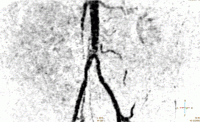And if you compare the differences in diameter from aorta to carotid, and to again much finer coronary arteries, 1 mm of calcium resolved in the coronaries wouldn't leave much for any calcium there.
Actually the precise words after MRI and ultra-sound by my internist at the time of the diagnosis were: 'up to 80% blocked'. Two years later on account of a second ultra-sound only: 'at least 70% blocked' ?!?
Which both are really fuzzy assessments, and if one looks at the actual MRI, anyone could make their own fuzzy guess, where I would say, even up to 90% from certain sides (click to enlarge):
Compare that picture of an diseased aorta with an others old TrackYourPlaque buddy's regression of calcification in the coronaries (click to enlarge):
The image below identifies (white circle) in left descending artery where my stent was placed nine years ago. The arrow points to wye (in cirumflex artery on backside) that WAS 90% occluded nine years ago; pretty much cleared up today.
 LeftDescending.png 175.97KB
0 downloads
LeftDescending.png 175.97KB
0 downloads
Keep in mind that the images show the heart sideways as I laid on my back. So, the top is to the left; bottom to the right.
Found further down a thread, where he also prescribes in great detail all interventions, and rationals for them (forum needs signing up, but is for free). If you read it you will find a different approach to mine, as mine is different to Patrick's, which is again different to Dr. William Davis. As in his study:
American Journal of Therapeutics 16, 326–332 (2009)
Effect of a Combined Therapeutic Approach of Intensive Lipid Management, Omega-3 Fatty Acid Supplementation, and Increased Serum 25 (OH)
Vitamin D on Coronary Calcium Scores in Asymptomatic Adults
William Davis, MD, FACC,1* Susie Rockway, PhD, CNS,2
and Mary Kwasny, ScD3
The impact of intensive lipid management, omega-3 fatty acid, and vitamin D3 supplementation on atherosclerotic plaque was assessed through serial computed tomography coronary calcium scoring (CCS). Low-density lipoprotein cholesterol reduction with statin therapy has not been shown to reduce or slow progression of serial CCS in several recent studies, casting doubt on the usefulness of this approach for tracking atherosclerotic progression. In an open-label study, 45 male and female subjects with CCS of ≥ 50 without symptoms of heart disease were treated with statin therapy, niacin, and omega-3 fatty acid supplementation to achieve low-density lipoprotein cholesterol and triglycerides ≤ 60 mg/dL; high-density lipoprotein ≥ 60 mg/dL; and vitamin D3 supplementation to achieve serum levels of ≥50 ng/mL 25(OH) vitamin D, in addition to diet advice. Lipid profiles of subjects were significantly changed as follows: total cholesterol 224%, low-density lipoprotein 241%; triglycerides 242%, high-density lipoprotein +19%, and mean serum 25(OH) vitamin D levels +83%. After a mean of 18 months, 20 subjects experienced decrease in CCS with mean change of 214.5% (range 0% to 264%); 22 subjects experienced no change or slow annual rate of CCS increase of +12% (range 1%–29%). Only 3 subjects experienced annual CCS progression exceeding 29% (44%–71%). Despite wide variation in response, substantial reduction of CCS was achieved in 44% of subjects and slowed plaque growth in 49% of the subjects applying a broad treatment program.
Which already seem to have worked for 44%, before the time he also added K vitamins, dropped statins and niacin in most cases, and other major changes to the studied protocol.
Edited by pamojja, 11 June 2019 - 09:52 PM.




























































